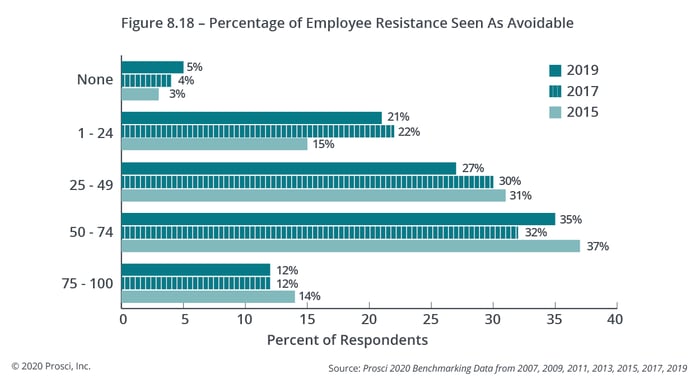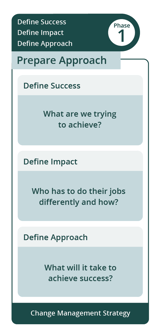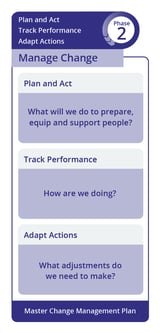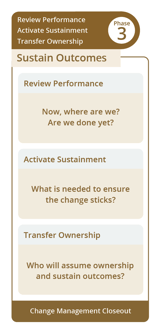Which Of The Following Statements Is True Of Managing Resistance To Change In An Organization?
Managing resistance effectively is critical to success with organizational change. Larn from thousands of change direction practitioners by following these 5 tips, which emerged from Prosci's Best Practices in Change Management research over the last 2 decades: Although resistance is a normal human response to change, we tin avoid or mitigate a significant amount of resistance by applying constructive alter management from the starting time of a project or initiative. Alter management is not just a tool for managing resistance reactively. It is well-nigh effective as a tool for activating and engaging employees in a change. Capturing and leveraging the passion and positive emotion surrounding a change often prevents resistance from occurring in the showtime place. Participants in Prosci's 2019 benchmarking study indicated that 47% of the employee resistance they encountered could take avoided by implementing effective modify management practices and principles. The moral here is: If you do alter management right the starting time time, you tin prevent much of the resistance from occurring. Actions for addressing and mitigating resistance include: Each of these tactics are function of a structured alter direction approach and directly address some of the main sources of resistance. They tin can actually preclude resistance from happening when they happen early on in the project lifecycle because they help front-line employees sympathise the "why" behind the change and see the commitment from leaders throughout the organization. This as well prevents resistance later in the project when it tin can adversely impact benefits realization, project schedules and budget. Do not be surprised by resistance! Even if the project solution is a wonderful improvement to a problem that plagues employees, in that location will be resistance to change. Comfort with the status quo is very powerful. Moving into an unknown time to come state creates anxiety, fear and stress, even if the current country is painful. Project teams and change direction teams should work to address resistance and mitigate it, and always look it. Research on human brain function shows that resistance is not only a psychological reaction to alter just besides physiological. To deed in a new fashion requires more than power from the brain. When presented with a new way of doing something, the physiological reaction is to revert back to what the brain already knows. Human beings tin can adapt their beliefs, but it is a hard and painful process—even for the brain itself. When preparing for resistance, spend fourth dimension before the project launches to look at likely sources of resistance. All too oft, a project team will reflect back on resistance and say, "We knew that group was going to resist the change," only naught was done to address information technology upfront in the project. When the project is getting started, be proactive and specific about where resistance is likely to come up from and the likely objections that bulldoze this resistance. So, human action on this knowledge ahead of time earlier the resistance impacts the project. Sources of resistance include: These groups are probable sources of resistance and should exist addressed proactively in the project lifecycle with targeted tactics for mitigating these objections. Managing resistance to change should non be solely a reactive tactic for modify management practitioners. Resistance prevention enables you to address and mitigate resistance early and should exist incorporated into your change management arroyo for projects and initiatives. Resistance direction is addressed with specific actions and activities in all three phases of the Prosci 3-Phase Procedure: Nosotros begin planning for resistance prevention while creating the Change Management Strategy deliverable in this initial stage. Actions center on early identification and predictable points of resistance, and special tactics for addressing them. Nosotros likewise identify specific risks by conducting Hazard Assessments during Phase 1 – Gear up Approach. Resistance prevention actions and activities are as well included in Phase 2 – Manage Change to support individuals through their ADKAR transitions. During Phase 2 – Manage Change, we also develop resistance response activities for persistent, pervasive resistance when information technology occurs. During this phase, you may likewise determine to develop a divide Resistance Direction Plan to develop additional tactics and complement your core Alter Direction Plans. During Phase 3 – Sustain Outcomes, we review performance to understand the initiative progress, ADKAR outcomes, and status of change management activities. Resistance management during Phase three – Sustain Outcomes consists of assessing performance of resistance direction activities and documenting lessons learned for the future. Formally addressing resistance ensures that it is understood and dealt with throughout the lifecycle of the project. This moves managing resistance to change from simply a reactive mechanism to a proactive and ultimately more constructive tool for mobilizing support and addressing objections. Managing resistance is ineffective when it merely focuses on the symptoms. The symptoms of resistance are appreciable and often overt, such as complaining, not attending fundamental meetings, not providing requested information or resource, or simply non adopting a change to a process or behavior. Although they are more than axiomatic, focusing on these symptoms volition not yield results. To exist constructive, you must look deeper into what is causing the resistance. Effective resistance management requires identifying the root causes of resistance to agreement why someone is resistant. Prosci's Best Practices in Change Management research provides a nice starting point for understanding the root causes of resistance. Results from the 2019 study revealed important themes in the peak reasons for resistance, which reaffirms the results from previous studies. When asked to identify the primary reasons employees resisted change, written report participants identified several root causes: Knowing these primary root causes, change teams can prepare a compelling example for the need for change, which senior leaders and so communicate to the organization. This simple action targets the peak crusade for resistance (i.e., lack of awareness) and can forbid much of it on a project or initiative. You can employ additional benchmarking findings and your own experience with change in your organization to customize your list of likely root causes with activities to address and mitigate each. The Prosci ADKAR Model and the ADKAR Cess also enable you to hone in on the root cause of resistance by identifying an private's barrier point and addressing that root cause. The ADKAR Model is a powerful diagnostic framework that can exist quickly and easily practical by change management teams and people managers in formal assessments or casual conversations. Finally, information technology is important to think that resistance to change is ultimately an individual miracle. Although research and analysis tin can identify general root causes for resistance, we must address resistance at the individual level. The all-time way to place the root cause of resistance is through a personal conversation betwixt a resistant employee and their people managing director. The change direction squad is not effective at resistance management. Project squad members, human being resource teams, and organization evolution specialists are not effective resistance managers either. The "right" resistance managers in an system are senior leaders and people managers, and they have different roles to play. At a high level, senior leaders help mitigate resistance by making a compelling case for the demand for change and demonstrating their commitment to a modify. Employees expect to senior leaders when they are deciding if a alter is important—and they judge what they see and hear from this grouping. If senior leaders are not committed to a alter or waver in their support, employees will also consider the alter to be unimportant and resist it. People managers are the other fundamental group responsible for managing resistance because they are closest to the employees who must ultimately prefer and utilize a change in their daily piece of work. If a people manager is resistant to a modify, or even neutral, their direct reports will probably follow suit. Fortunately, the reverse is also true. An openly supportive people manager who advocates for a particular change is likely to come across the same behaviors in their employees' reactions. Prosci'southward benchmarking data reveals v key roles of people managers during change, and two connect directly to managing resistance: 1) Demonstrating support for the modify and 2) Identifying and mitigating resistance. Of course, you must first accost resistance from people managers themselves before asking them to manage resistance in their teams. The alter team or practitioner can exercise much of the legwork in understanding and addressing resistance, just the office or face of resistance management inside the organization belongs to senior leaders and people managers. The change practitioner's role is to enable the "right" resistance managers by providing data about where resistance is coming from, identifying likely root causes, offering potential tactics for addressing resistance, and providing tools to identify and manage resistance. Just the "right" resistance managers must take activity to accost objections and assistance employees move successfully through the change process.
1. Practice Change Management Correct the First Time

2. Look Resistance to Alter
3. Formally Manage Resistance to Alter

Phase 1 – Prepare Approach

Stage two – Manage Change

Phase 3 -Sustain Outcomes
4. Place the Root Causes of Resistance to Change
5. Appoint the "Right" Resistance Managers
Senior Leaders
People Managers
Source: https://www.prosci.com/resources/articles/tips-for-managing-resistance-to-change
Posted by: combsobjer1979.blogspot.com


0 Response to "Which Of The Following Statements Is True Of Managing Resistance To Change In An Organization?"
Post a Comment